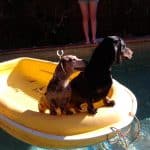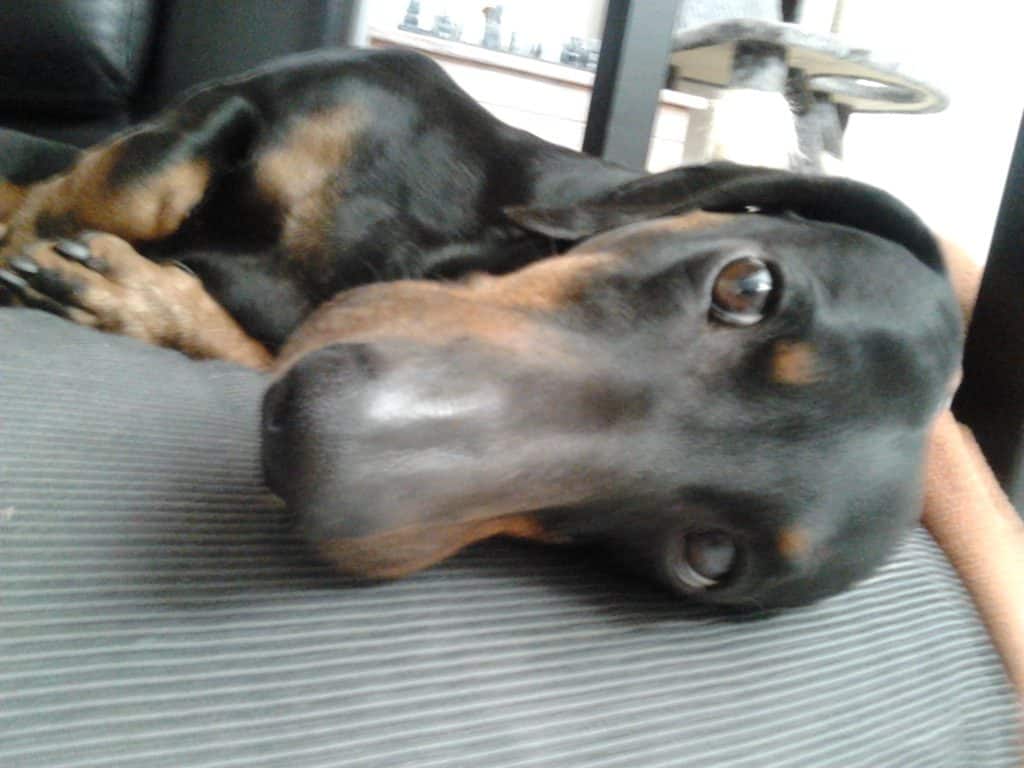Famous
During the last eight years I’ve nursed my beautiful boy, Famous, conservatively through 11 IVDD episodes. He’s a standard, short hair, black and tan boy and his discs are like timebombs. We’ve been very lucky; in between disc episodes he acts like he has no idea he has a bad back and still behaves like a puppy even though he’s almost 12.
The choices I was given were: 60% chance of success with surgery, or euthanasia. I didn’t think 60% was worth the risk and euthanasia was out of the question as I felt if it came to the worst case scenario, he could have had wheels, not a death-sentence.
As it turned out, his next disc would have happened post-operatively had we gone ahead with surgery, so I’m glad we didn’t take that path. He had six slipped .discs diagnosed that first year and surgery would not have prevented any of them. Nor would it have prevented any of his numerous relapses. As ground-breaking as the surgery is, it’s not a quick-fix and my dog’s surgeon advised it’s actually better, if possible, for his discs to resolve naturally.
Before the surgery was available, the only option for IVDD was crate rest.
It doesn’t get any easier with successive IVDD episodes but finding the DISA support group was the best thing for me as I felt very isolated, helpless and desperate that first year when they kept diagnosing additional discs, all while he was already on crate rest. We had many panicked, tearful trips to SASH in the small hours of the morning.
I grew up always with a Dachshund in the house and I took every precaution with Famous. He has never been allowed off the floor, I get down to cuddle him on the floor and when we’re out I have always carried him up and down stairs. He has ramps and gates everywhere uneven (inside and outside) and where he likes to jump.
I have tiles and wood floors and he used to love sliding around the corner and flying onto his bed, which would then slide across the floor, so when his back went, his bed was reupholstered (non-slip fabric) and I put mats down everywhere (I learned the hard way that slipping has a high correlation with lumbar disc episodes – non-slip booties are another option) and he now regularly sees a canine physio. My dog used to jump on and off his main ramp halfway, so it became a tunnel. He must think I’m the fun-police but that’s better than the alternative!
My beautiful, sweet-natured boy was first diagnosed with a cervical disc issue at seven months of age (not a good indicator), this resolved with meloxicam and rest.
His next diagnosis was a thoracic disc between four and five years old. He began crate rest and improved over the first three weeks and then he suddenly relapsed. He seemed to improve again but then took a turn for the worse and was diagnosed with three additional discs in the middle of his back. His improvement was much slower after that and then he started crying when I gave him his meals. This turned out to be a cervical disc and all four of his legs were affected. I took extra care to ensure his neck was always supported (with a towel, blanket or pillow) and I hand-fed him because he was struggling to move his head and neck.
He was almost given the all-clear after what seemed like forever but then a lumbar disc was diagnosed.
Those six discs had him out of action for almost 12 months but he pulled through and I gradually built up his fitness and took him to rehabilitation with a wonderful canine manipulator who was crucial in resolving the hunch-back that my boy had developed. He was doing really well, apparently was unaware he had a bad back and generally acted like he thought he was a puppy and life was good.
Devastatingly he was attacked by a malamute, who brutally shook him (I can never unsee it, it was reminiscent of those nature documentaries when killer whales fling baby fur seals, it still upsets me). At first it appeared that he was unable to stand up because of the nasty puncture wounds but as these healed it became obvious that the attack had triggered another disc. This time it was a text book case of eight weeks crate rest and he was good to build up again.
We had about two years clear when he needed a hernia operation (apparently when the malamute shook him it tore the muscle-membrane at his groin, which increased over the next two years until his bladder went through the gap), the operation was successful and the team were careful to treat him as a spinal patient (this was included in the surgical contract) but nonetheless it triggered another disc. Happliy that also resolved with eight weeks crate rest.
We had another two years without any issues until last year, when I nursed him through three more IVDD episodes. They were just one at a time, with a few relapses so that was another year written off to IVDD. He’s built back up again, he is different every day and I often over-react, thinking everything is a sign of it starting again, but he’s been great for almost four months which I’m grateful for. My hope (given his history & his age) is that he stays strong & healthy as long as possible and certainly while we go through Covid-19 lockdown.
I think our bond has been solidified through IVDD. I don’t wish this on anyone but because we’ve been through this so often, he understands and accepts the crate (it took eight IVDD episodes to stop being hysterical). When he needs to go to the toilet, he stands (or raises himself as best he can depending on his condition) and looks in my eyes. He understands “do a wee” and “do a poo”.
Training him was over when his back went but I’m glad I was strict with him when he was young, otherwise I’d never be able to take him for walks post-IVDD because if he was still straining & tugging at the lead, we would have had to give up walks because he would be jarring himself. Sometimes I still have to pick him up when he gets too excited to remember not to pull, but on the whole, he is amazing. He still loves the vet (he gets so excited I definitely have to carry him at the vet!), he flirts with everyone and he loves all dogs and all people.
For anyone on this path with your little one, whatever treatment choice you make, stay strong, let the recovery take as long as needed, follow your specialist’s advice. Watch your dog’s weight, don’t let your dog convince you of early release from the crate, seek rehab (for the dog, maybe therapy for yourself), wait for the all-clear and give lots of love.
Sonja & Famous



